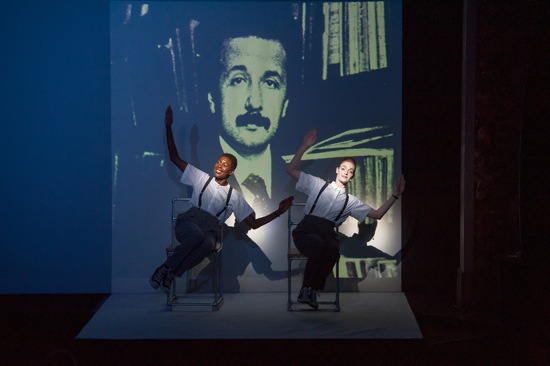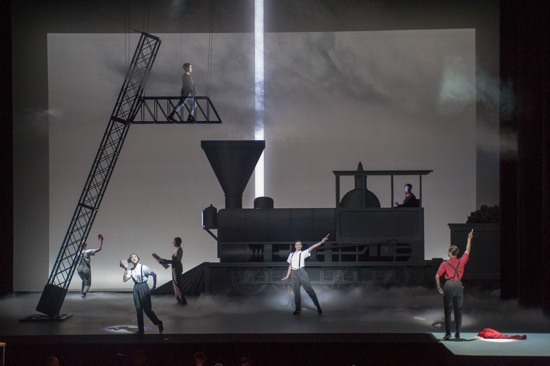A slender, beautiful black woman, wearing a black, high-necked 19th-century gown, sits motionless in a wooden chair on a stage covered with sand. A stuffed raven perches on her wrist. She sits there for a very long time. The stage is that of the Brooklyn Academy of Music’s Opera House, the women is Sheryl Sutton, it’s 1970, and the image occurs in Robert Wilson’s The Life and Times of Sigmund Freud (1970). Those who know Wilson primarily for his radical productions of operas might not remember his magical, mystifying early works that include The King of Spain (1969) and Deafman Glance (1971)—the three mentioned finally brought together at BAM in 1973 as an all-night marathon titled The Life and Times of Joseph Stalin. Slowness was a given, along with repetition.
Einstein on the Beach (1976) marked a slight shift in Wilson’s work. For one thing, it has a through-composed score by Philip Glass and a scenario that incorporates the singers into the action. For another, references to Einstein occur throughout—however obliquely—as do scenes that bring to mind the famous trial of Patty Hearst, which took place the year Wilson created what he identifies as An Opera in Four Acts. For spectators, trying to connect the great physicist and mathematician to the rich, well-brought-up girl turned revolutionary might not be a useful pursuit.
The elegant, glistening, epochal work, which lasts almost four-and-a-half hours, has had previous revivals (1984 and 1992). The 2012 remounting came to BAM in the middle of a tour that ends next March in Hong Kong. What struck me in 1976 and strikes me now is the intriguing balance between the wildly imaginative, occasionally playful, almost irrational-seeming choices that Wilson makes and the fastidiously polished beauty of their execution. Watching Einstein, you get a sense that each gesture, each timing, each tone of voice has been set just so and that any deviation may be impermissible. Even members of the crew that changes the complicated sets walk on with robotic clarity, turn like soldiers, and maintain steady rhythms (they take a curtain call too, and their jubilation during it is understandable).
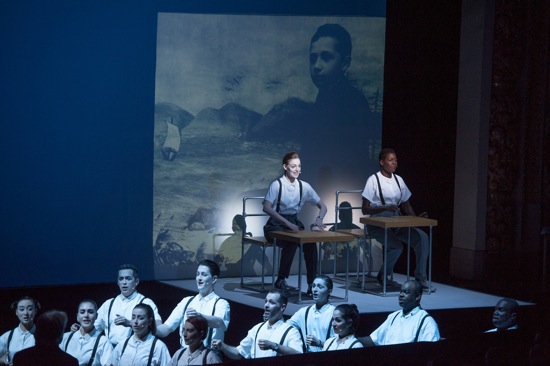
Kate Moran (L), Helga Davis, young Einstein, and the Chorus during “Knee Plays.” Photo: Stephanie Berger
The opening scenes introduce Wilson’s pristine style. While the audience is assembling, Kate Moran and Helga Davis file in, turn, and take their places on two chairs close to the front of the stage for a series of “Knee Plays.” Both wear the uniform that clothes all the singers and actors: beige trousers; white, short-sleeved shirts; suspenders. Like Lucinda Childs and Sheryl Sutton in 1976, one woman is white, the other black; one smiles, the other doesn’t. They speak softly at first—the same passages over and over—each articulating almost inaudible words and numbers. The women’s hands are busy with slightly different tasks—one finger, two fingers. They could be working on consoles, adding machines—hard to be sure.
When the twelve expert singers enter the pit one by one, their heads appear over its railing as if they were being raised on individual elevators. Each looks in a different direction, and each has a subtly distinctive facial expression. All wear makeup. They freeze like that in a chilly light until Michael Riesman, the musical director of the Philip Glass Ensemble, cues them to begin their single-note litany of counts (“1,2,3,4,5,6,7,8, pause, 2,3,4, 1,2,3,4,5,6. . .”—and similar sequences) and solfège syllables. As jurors in the two trial scenes (the second titled “Trial/Prison”), they enter the jury box as neutrally and devoid of individual tics as the two court stenographers (Sharon Milanese and Shakirah Stewart), who type efficiently on air. All bear brown paper bags, and all remove take-out coffee containers and sip in unison.
- (L to R) Hai-Ting Chinn with shell, Helga Davis, Caitlin Scranton, Tomás Cruz. Jasper Newell above. Photo: Stephanie Berger
Einstein, it is said, loved model trains as a boy (he also used a “train paradox” to explain aspects of his Theory of Relativity). Clouds of smoke herald the appearance of a huge locomotive that periodically slides partway onto the stage, retreats, and reappears. Dancer Caitlyn Scranton creates her own back-and-forth track on a diagonal to it. But she never pauses, as the keyboard and synthesizer components in Glass’s ensemble spiral wildly along and the singers belch out syllables.
Einstein’s choreographer, Lucinda Childs (who performed this solo in the original production) keeps Scranton stepping lightly and springily in patterned sequences of varying lengths. Scranton maintains a focus that’s slightly high and to her left and brandishes a pipe stem (Einstein was a dedicated pipe smoker) like a conductor. Meanwhile, Tomás Cruz draws patterns on the air with his hands; he’s identified in the program as “Man with Red Shirt Calculating.” High above the scene, on what looks like a truncated bridge attached to a standing girder that gradually tilts, stands a small boy (Jasper Newell) who occasionally takes a paper airplane from inside his jacket and launches it over the stage, as if testing Newton’s theory of gravity.
In “Night Train,” a caboose shows the audience its back, and a man and woman (Gregory R. Purnhagen and Davis, costumed in 19th-century clothes—perhaps Einstein and his wife?)) emerge onto its balcony to take the air, lip-synching the duet of solfège syllables that Lisa Bielwa and Philip Anderson are singing in the pit.
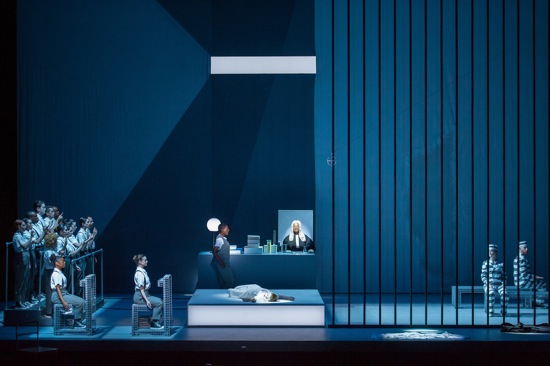
“Trial/Prison.” (L to R) Chorus with pipes, Shakirah Stewart, Sharon Milanese, Helga David, Kate Moran, Charles Williams, Anne Lewis, Ty Boomershine. Photo: Stephanie Berger
The two trial scenes do not develop in a linear fashion, although the second one shares the stage with its outcome: in a barred cell, Ty Boomershine and Anne Lewis, wearing prison stripes, grapple. Davis as Lawyer speaks some of the same non sequiturs she delivered in one of the Knee Plays (a short speech written by Chrisopher Knowles called “Mr. Bojangles”), while Moran, as Witness, lies on a giant bed, repeating softly over and over into a mic a text that begins “I was in this prematurely air-conditioned supermarket. . . .” The chief judge (Charles Williams) ends by delivering in a hoity-toity falsetto rules about kissing for well-brought-up girls. Almost everything else that happens in the courtroom is controlled and jerky, in contrast to the smoothness with which the stagehands assemble and take apart the set. The two bewigged judges (Williams and little Newell) separate each word of “this court is now in session” and bang their gavels ceremoniously. The stenographers file their nails in exact unison while waiting for the trial to begin. I’m reminded of the automatons in the National Museum of Monaco who perform their small, clockwork tasks until their mechanism runs down.
Wilson and Glass orchestrate their scenes into a contrapuntal wonder, and as the initial trial scene begins, a solo violinist, wearing an Einstein wig and the shirt-trousers-suspenders attire, makes a first appearance to occupy a chair that’s been sitting downstage all along and add a rapid, panting element to the mixture. (Jennifer Koh and Antoine Silverman alternate in this role.)
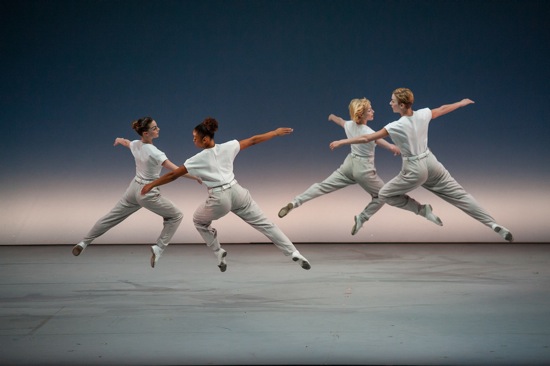
(L to R) Sharon Milanese, Shakirah Stewart, Katherine Helen Fisher, Katie Dorn in “Dance 2”. Photo: Stephanie Berger
Childs’s two group dances are themselves a counterpoint to the moving tableaux of other sections. No scenery is involved, and Urs Schoenebaum, who’s credited with the uncanny lighting design along with Wilson, creates a beautiful, subtly altering wash of blues and rosy or amber shades on the cyclorama. The nine dancers (now minus suspenders) appear to be skimming across an open field under a changing sky. Their limited vocabulary of repeating steps in geometrical patterns could be referred to using ballet terms, such as chassé, sauté de basque, jeté, but these are so fluid and understated that the comparison could be misleading. The second dance involves different floor patterns, with the violinist adding to Glass’s ordered turbulence. Both dances seem to cleanse the stage, to liberate it with their accelerated motion.
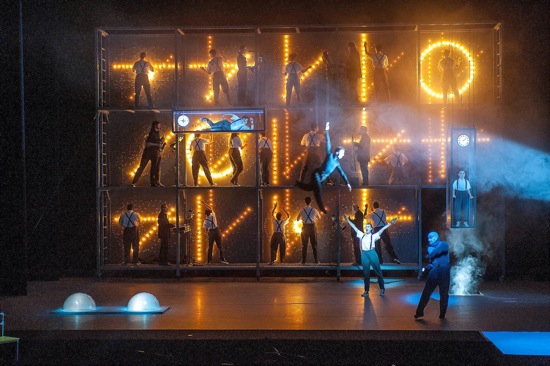
Sharon Milanese and Jasper Newell in elevators, Lonnie Poupard, Jr. flying, Caitlin Scranton, Ty Boomershine. Photo: Stephanie Berger
Einstein reaches a scenic and musical climax in the section titled “Spaceship.” Performers are slotted into a three-storied structure that fills the stage. Making workmanlike gestures, they appear to cause a changing light display; horizontal, vertical, circular, and diagonal strings of bulbs light up and black out in some unfathomable order elevated to heroic proportions by the Glass Ensemble (wind, brass, and keyboards plus electronic equipment) and the singers. Newell constantly rises and sinks in a little glass elevator, while Milanese moves right and left in one set horizontally, and Lonnie Poupard, Jr. flies occasionally through on a harness. The human workers inhabiting the dazzling hive of dials and trajectories glorify the one of the scientific advancements that Einstein’s theories made possible (another—the atomic bomb—is alluded to in a slide projection and an explosion).
At some point, I feel surfeited and begin to tire, even given the wonders passing by: the virtuosic saxophone solo by Andrew Sternman; the tower with a woman calculating in its top window, while others watch from below; the person (Katie Dorn) who, a number of times, holds up a book and with remarkable endurance keeps turning her head rapidly side to side in championship-level speed reading; Boomershine’s violent dance in demonic makeup; Hai-Ting Chinn’s solitary, sweet-voiced solo—her head only appearing out of the pit. . .and more, more, more.
Not everyone who entered BAM’s Howard Gilman Opera House at 7 P.M. was still there at the finish. They missed the unexpected ending: Williams telling a story whose message was that we cannot live without love. And they couldn’t join the still rapt spectators who sprang to their feet to cheer the spectacle, the heroic performers, and the man from whose brilliant, unusual, witty mind Einstein on the Beach sprang.

